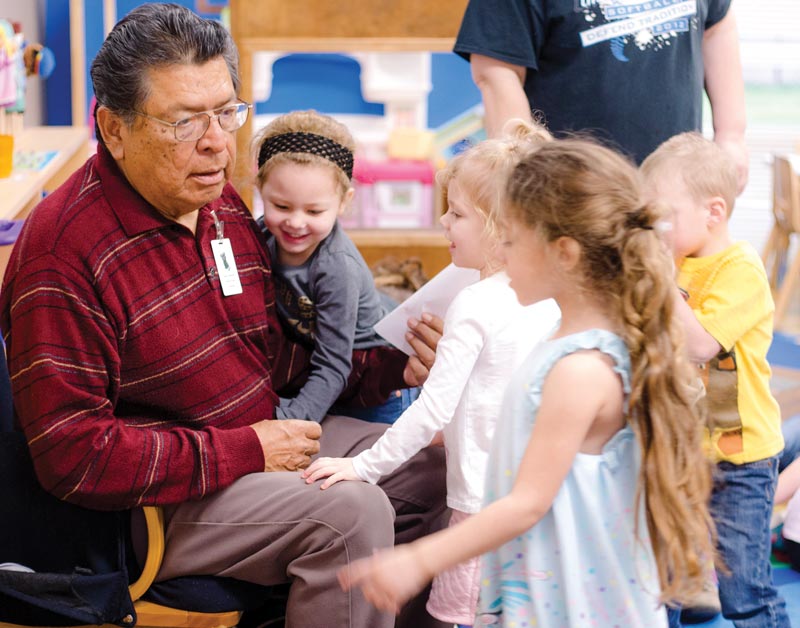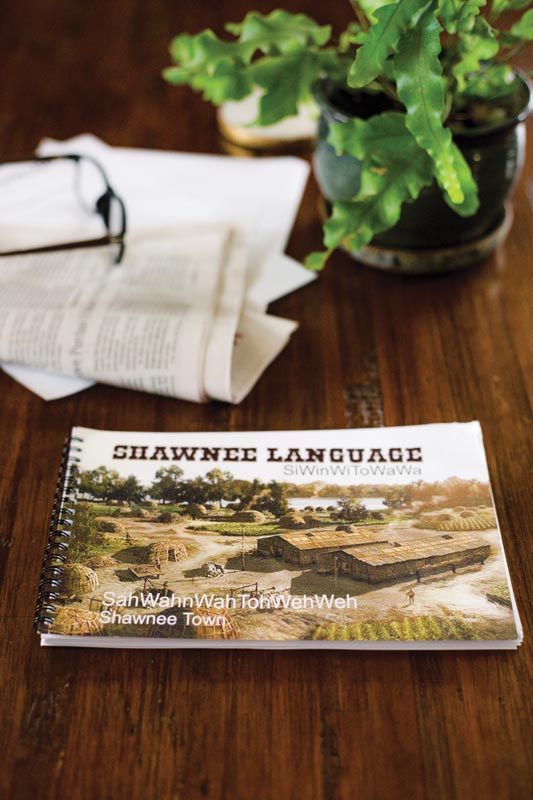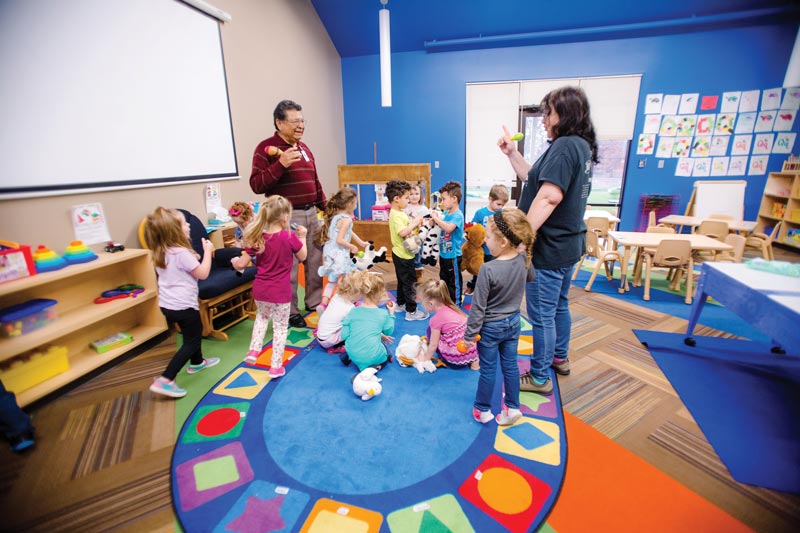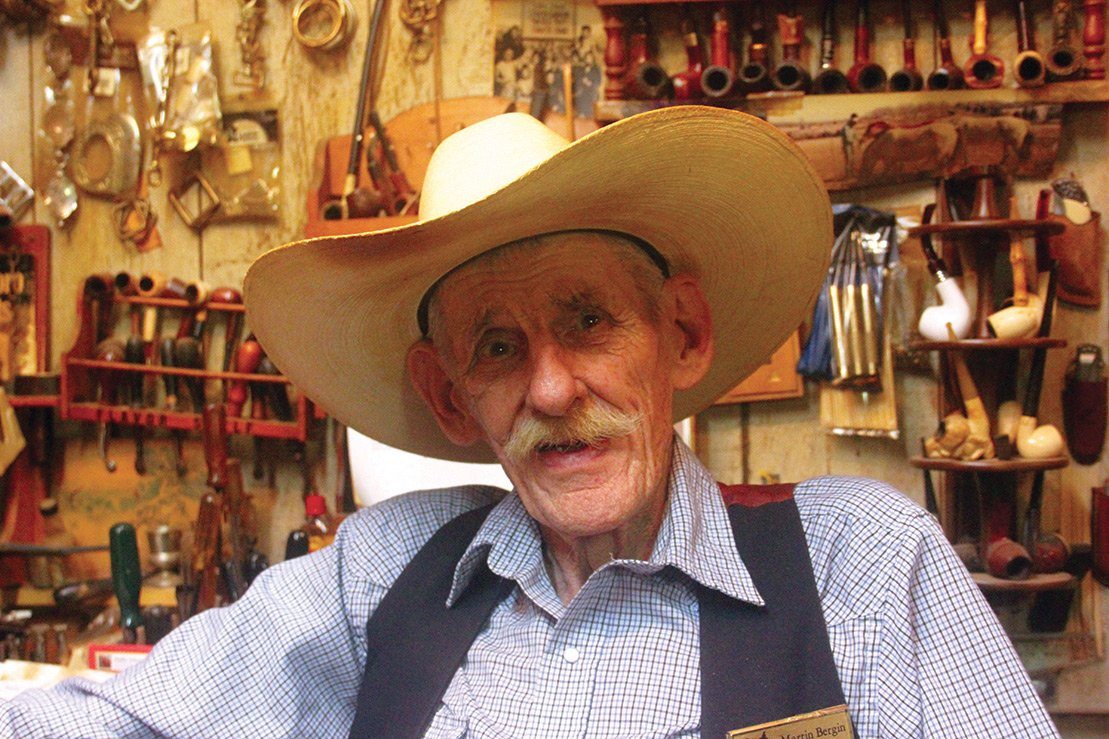If you ask George Blanchard to lunch in Seneca, he’ll pick the local casino’s Shawanoe Restaurant just across the state line in Oklahoma. There, you can have the Mikkinwheh Yaw Kaw Sandwich, which translates to “meat of the animal”: crispy bacon, smoked sausage, fried bologna, and beef brisket layered over a slab of Indian fry bread. For customers ordering it, that singular phrase might be the only Shawnee words they ever utter. As one of the last fluent Shawnee speakers in the tribe, George hopes to change that.
He grew up in the Little Axe community, on an Indian allotment near Norman, Oklahoma, where Shawnee was the only language spoken. George didn’t learn English until he was 5 years old. Throughout adulthood, he worked as a bricklayer and a casino security guard; later, he owned a construction company. George served as governor of the Absentee Shawnee tribe, one of three federally recognized Shawnee tribes, from 2009 to 2013. The following year—after his late wife, Linda “Sue” Blanchard, saw an opening for a language specialist in Seneca’s Eastern Shawnee Cultural Preservation Department—they moved across the state line. Now in Missouri, George is carving out a late-in-life career from his mother language.
His mastery of Shawnee—an airy language punctuated by occasional sharp consonants—has made him a darling of film producers. George has provided translations and language coaching on projects including Ric Burns’s 2009 PBS series We Shall Remain and the 2018 History Channel documentary series Frontiersmen. But George’s true priority lies in language education for fellow Shawnee tribal members.
In the Shawanoe Restaurant, he visits with Chief Glenna Wallace and chats with waitresses and security guards, slipping in and out of Shawnee with ease. Cycling between two languages is fun, but it’s not enough.
“I’m running out of people to talk to,” he says.
Such is the state of most pre-settlement languages in this country. George knows no tribal members whose fluency matches his own. Given current projections for native languages across the United States, the outlook is bleak. According to The Language Conservancy, some 300 languages existed on the North American continent when European settlers first arrived. Fewer than 12 are expected to survive the coming decade.
George’s efforts in southwest Missouri caught the eye of the Missouri Humanities Council, which embarked on a project in 2016 to honor the state’s native heritage.

“While some may view this as penitence of sorts for undertaking—consciously, unconsciously, and subconsciously—a policy of genocide over the course of four centuries, I refuse to make this endeavor a feeble gesture to atone for any ostensible guilt for the actions and equally deplorable inactions of my generation and of my predecessors,” wrote the council’s executive director, Steve Belko, in MO Humanities magazine. “We are here to do what we can to help native communities preserve their culture, plain and simple.”
The Humanities Council partnered with Perry County on the eastern side of Missouri, which is home to a large, relocated 1780s Shawnee settlement called Le Grande Village Sauvage (French for “the big savage village”), to support a grass-roots effort to procure land that might eventually provide the Shawnee with a dedicated ceremonial site.
“It’s important to me because it is a thread of our heritage that if we do not preserve, if we do not celebrate what is special about it, future generations won’t even know what was here,” says Trish Erzfeld, Perry County Heritage Tourism director.
But when it comes to preserving the language, George limits input from nontribal members. He says he’d rather have them help with grant applications than with the intimate language workshops and data collection. He believes tribal members must do the work to keep the language alive.
“My father used to say that if you want help from the Creator, you have to speak with the language you were put here with.”
One of George’s most vivid memories from childhood in the late 1940s is of his grandmother shouting, “Pikefoko!” (go hide!) when strange cars—possibly Indian agents— drove through the neighborhood looking for idle children. As he and his siblings raced to hide under the floor of their barn, his grandmother’s orders seemed like a prompt for an innocent game. But over time, he figured out that she was shielding them from the cruelties of the era’s federal Indian education practices, which sent Indian children to boarding schools for forced assimilation. In most schools, abuse ran rampant. Indian names and words were banned for the sake of the “Kill the Indian, Save the Man” philosophy. Generations of young Indians were shamed into silence and cultural erasure.
Today, George is a rare, living bridge between two worlds. He has remained fluent in Shawnee. After years of not using the language, most of his fellow tribal members speak only English. That’s a painful fact, but learning how to speak the mother language may oer a path forward.
George says it’s a matter of pride. “If you look at them, a lot don’t look native. I think they’re wanting to prove they are. If I didn’t speak Shawnee, I would feel less Indian.”

The Eastern Shawnee Cultural Preservation Department is a long, squat building that sits along the Oklahoma-Missouri border less than a mile west of the Seneca Dairy Queen. It is dedicated not just to the past, but also to teaching contemporary tribal members cultural customs that keep their heritage alive. The center has invited artists such as Levi Randoll to teach the craft of making moccasins, known in Shawnee as holi efani. In February, several tribal members attended a workshop on tapping and boiling down tree sap to make syrup.
The adjacent Betty Jane Holden Admussen Museum includes work from tribal artists such as basket maker David Carpenter and various paintings and ceramic pieces by Janet Hansen. There are also exhibits featuring ceremonial dresses, arrowheads, and hunting tools. One of the most prominent artifacts is a newspaper encased in glass in the museum lobby. The display showcases an 1841 issue of the Siwanwi Kesibwi/Shawnee Sun, an Indian publication written entirely in Shawnee, but whose meaning was lost to the tribe for several generations. In 2008, George translated it into English, revealing Biblical teachings from a Baptist Kansan missionary named John Meeker. Some academics have proposed that such publications were used to encourage literacy. Today, it functions as a side-by-side comparison of Shawnee and English, a historical portal linking two languages.
But it’s still not enough, George says.
“There are deep things you can’t explain in English that you can in Shawnee,” he says. “It’s a spiritual language. Everything means something: the ground, the trees, the relationship of sky, water, rock. My father used to say that if you want help from the Creator, you have to speak with the language you were put here with.”
It is insuffi cient, George says, to simply glance at words as though they are artifacts or mere novelties. His goal is true comprehension, free from the veil of English. Without it, tribal members cannot access the cultural weight of inherited stories, songs, and ceremonies.
The Shawnee tribe is one of 567 recognized by the US federal government. Tribal sovereignty is outlined in the US Constitution as legal fact, but its contemporary existence is often muddied by confusing administrative processes and outside political interests. Some tribes waited for more than 30 years for federal recognition. Many are still waiting. It is not unheard of for tribes—such as the Menominee, Chinook, Schaghticoke, and Eastern Pequot—to lose federal recognition. When that status is rescinded, paths toward economic viability, such as gaming rights and federal tax exemptions, disappear.
The criteria for federal recognition mandates, among other things, that a tribe be composed of a distinct community with a clear historical lineage. To many Indians, including George, language defines that “distinct community” standard. From that perspective, reviving the Shawnee tongue isn’t just motivated by nostalgic and romantic notions to preserve heritage but is central to securing the tribe’s future.
There has been scattered offi cial support for such efforts. In Montana, the Indian Education for All bill provided funding for tribes to develop language classes and a course curriculum that promotes and preserves tribal heritage. At the University of North Carolina, fluency in Cherokee satisfies the foreign language requirement for students. In an ideal world, fluent young speakers eventually would rise to become tribal leaders, ultimately preserving sovereignty.
The Shawnee tribe has not arrived at that ideal point yet, but reality doesn’t faze George’s doggedness. Competitive federal dollars for language preservation exist. It’s just a matter of securing them. In 2017, he received a grant from the Institute of Museum and Library Services to write a Shawnee language dictionary that was distributed to every household in the tribe. It’s filled with useful phrases, such as Logohe patake nap’yi (I will be right back) and Wekoge nehotimafe newinekiti yatf’wep’yayike (I’ve had a busy day and lost track of time), meant to be practiced at home. His Facebook group, “Let’s Talk Shawnee,” has more than 400 members, and the Eastern Shawnee Cultural Preservation Department regularly posts George’s video language lessons on social media. In the tribal newsletter, The Shooting Star, he publishes a list of Shawnee phrases for readers to recite.

George also teaches language courses at a pre-Head Start program in Seneca. With the assistance of audio language translator devices for books like The Story of Our Corn by Renee Gokey, young students learn to read, write, and pronounce Shawnee words. Children can absorb the new vocabulary with startling ease, but they lack opportunities to practice speaking outside the classroom. At home and among extended family, the dominant language is English.
“A big problem here is there are no ceremonies that we do to use the language, or even to hear it,” George says, citing Bread Dance, Green Corn Dance, and War Dance as lost cultural practices that would expose tribal members to the Shawnee language. Today, even ordinary functions such as funerals are typically conducted in English. “So the little kids are coming home and talking Shawnee but the parents don’t know what’s going on,” George says.
To counter that, he offers an adult language course in the Eastern Shawnee Cultural Preservation Department on Tuesdays and Thursdays. The beige classroom is simple, with tables arranged in a U shape around a projector. Shawnee signage identifies the cardinal directions of the walls. To boost attendance, the course includes free meals.
On this particular night, dinner is a steaming hominy and elk stew, fry bread, and a grape dumpling dessert known as skipah. The first to arrive is Larry Dushane, a longtime student of George’s who spoke zero Shawnee until four years ago. A bolo tie hangs from his neck, and his silver ponytail is segmented by rubber bands. Next comes Chief Glenna Wallace, who peers out at the world through glittering eyes; a restless 13-year-old named Matthew Mackie; and a man named Brett Barnes who attends because, he says, “There’s nobody else to talk to.” Another student is the soft-spoken Eric Wensman, a Shawnee language instructor from Miami, Oklahoma, who comes because there’s always more to learn, and he’s not as fluent as George.
No one in the tribe is as fluent as George.
Overall, 12 people sign the attendance sheet. The lesson explores the differences between phrases like “I want” (Neskitilalati) and “I need” (Netikiwiti), but conversation also strays. Class members tell jokes and stories about their families.
George’s classroom has one window. Cultural center visitors passing by might see him at the table, surrounded by eager students. Within the glass that divides onlookers, viewers will find a faint reflection of themselves, too.
Related Posts
Meet the Missouri Veteran Who Makes Gold-Medal Burgers
When Sedalia resident Terry Shull won the 2017 Missouri State Fair Burger Contest, he did it his way. With 17 years of cooking under his belt, Terry has learned to experiment and try new recipes.
Meet Missouri Farmers Kalena and Billy Bruce
Meet some of the farmers raising the beef you eat right here in Missouri, plus, we share a recipe for slow-cooker shredded beef.
Meet The Saddlemaking Cowboy Poet of Missouri
A widower since 2011, Martin still surrounds himself with the stock in the trade of saddle making. His workspace is as much a museum of leather crafting as it is a saddle shop.



